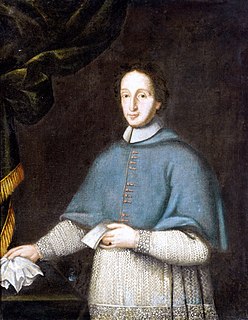Related Research Articles

Luigi Caetani was an Italian Cardinal of the Roman Catholic Church.
Ambrosio Fracassini, O.P. was a Roman Catholic prelate who served as Bishop of Pula (1663).
Scipione Pannocchieschi d’Elci was a Catholic cardinal who served as Apostolic Nuncio to the Republic of Venice and as Archbishop of Pisa.
Ulpiano Volpi or Volpiano Volpi was an Italian Roman Catholic prelate who served as Archbishop of Novara (1619–1629), and Archbishop of Chieti (1609–1615).
Muzio Gaeta (1663–1728) was a Roman Catholic prelate who served as Archbishop of Bari-Canosa (1698–1728) and Titular Patriarch of Jerusalem (1708–1728).
Tegrimus Tegrimi was a Roman Catholic prelate who served as Titular Patriarch of Jerusalem (1638–1641) and Bishop of Assisi (1630–1638).
Carlo Loffredo, C.R. was a Roman Catholic prelate who served as Archbishop of Capua (1698–1701), Archbishop of Bari-Canosa (1691–1698), and Bishop of Molfetta (1670–1691).
Alessandro Carlo Gaetano Varano (1667–1735) was a Roman Catholic prelate who served as Bishop of Macerata e Tolentino (1698–1735).
Giulio Dalla Rosa or Giulio Della Rosa (1642–1699) was a Roman Catholic prelate who served as Bishop of Borgo San Donnino (1698–1699).
Uldericus Nardi (1637–1705) was a Roman Catholic prelate who served as Bishop of Bagnoregio (1698–1705).
Michele Gallo Vandeinde was a Roman Catholic prelate who served as Bishop of Capri (1698–1727).
Carlo de' Vecchi was a Roman Catholic prelate who served as Titular Archbishop of Athenae (1667–1673) and Bishop of Chiusi (1648–1657).
Francesco Gaetano or Francesco Caetani was a Roman Catholic prelate who served as Titular Archbishop of Rhodus (1652–1670) and Apostolic Nuncio to Spain (1652–1654).
Gaetano De Andrea, C.R. (1630–1702) was a Roman Catholic prelate who served as Bishop of Monopoli (1698–1702).
Michele de Bologna, C.R. (1647–1731) was a Roman Catholic prelate who served as Archbishop of Amalfi (1701–1731) and Bishop of Isernia (1690–1698).
Francesco Nerli, seniore (1594–1670) was a Roman Catholic cardinal.

Luigi Ruzini (1658–1708) was a Roman Catholic prelate who served as Bishop of Bergamo (1698–1708).
Fortunato Ilario Carafa della Spina (1630–1697) was a Roman Catholic cardinal.
Antonio Forteguerra, O.S.B. (1648–1714) was a Roman Catholic prelate who served as Bishop of Pienza (1698–1714).
Bonaventura Poerio, O.F.M. Obs. (1648–1722) was a Roman Catholic prelate who served as Archbishop of Salerno (1697–1722).
References
- ↑ Ellen Rosand, Opera in Seventeenth-Century - Venice: The Creation of a Genre, Berkeley, University of California Press, 1991, p. 152-153.
- ↑ (in Italian) Pompeo Molmenti, Venezia alla metà del secolo XVII : relazione inedita di monsignor Francesco Pannocchieschi, Roma,Tipografia della Reale Accademia dei Lincei, 1916.
- ↑ (in Latin) Pius Bonifacius Gams, Series episcoporum Ecclesiae catholicae quotquot innotuerunt a beato Petro apostolo, Leipzig, Hiersemann, 1931.
- ↑ Cheney, David M. "Archbishop Francesco Pannocchieschi d'Elci". Catholic-Hierarchy.org . Retrieved June 16, 2018.